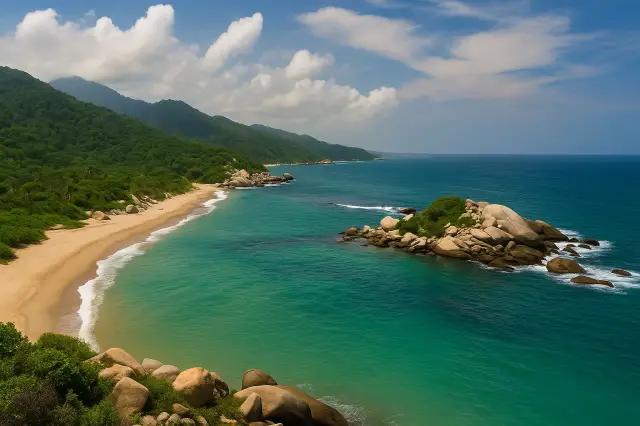Colombia's natural wealth in its national parks
Colombia is one of the most biodiverse countries in the world and boasts a network of more than 60 natural parks that protect unique ecosystems and offer unforgettable experiences for travelers. By 2025, these sites will be consolidated as key destinations for sustainable tourism and connection with nature.
From the pristine beaches of the Caribbean to the Andean mountains and the Amazon rainforest, Colombia's natural parks are true sanctuaries for those seeking adventure, relaxation, and contact with biodiversity.
Tayrona National Natural Park, a treasure of the Caribbean
Tayrona National Natural Park remains one of Colombia's most visited destinations. Located in Santa Marta, this park combines tropical rainforest, idyllic beaches, and archaeological remains of the ancient Tayrona culture.
Its main attractions include:
Playa Cristal and Cabo San Juan, ideal for relaxation and diving.
Ecological trails to Pueblito Chairama, an ancient indigenous settlement.
Native birds and fauna such as howler monkeys and deer.
Tayrona is also a model of sustainable tourism management and one of the most popular destinations for national and international travelers.
Los Nevados National Natural Park
Los Nevados Park , located in the Eje Cafetero region, is another of the most visited in 2025. Its landscape, dominated by the Nevado del Ruiz , Nevado de Santa Isabel and Nevado del Tolima volcanoes, attracts thousands of hikers and ecotourism lovers.
Recommended activities:
Ecological walks to glaciers and moorlands.
Bird watching and high mountain photography.
Rural tourism in the municipalities of Manizales, Pereira, Salento and Murillo.
Its environmental importance is crucial, as it provides water to more than 2 million people in the center of the country.
Amacayacu National Natural Park
Located in the heart of the Colombian Amazon , Amacayacu Park represents biodiversity at its finest. It is home to more than 500 bird species , 150 mammals , and indigenous Tikuna communities that maintain their culture.
Among the most sought-after experiences in 2025:
Canoe tours on the Amazon River.
Sightings of pink dolphins and alligators.
Cultural exchanges with indigenous communities.
Tourism here is focused on conservation and respect for ancestral traditions.
Sierra Nevada de Santa Marta National Natural Park
This park is a symbol of spirituality, biodiversity, and culture. The Sierra Nevada de Santa Marta is considered the "heart of the world" by the Kogui, Arhuaco, Wiwa, and Kankuamo indigenous communities.
Visitors highlight:
Hikes to the Lost City (Teyuna) , one of the most important archaeological destinations in Latin America.
Ecosystems ranging from sea level to 5,700 meters above sea level.
Community and spiritual tourism experiences.
In 2025, the Sierra continues to attract travelers seeking an authentic connection with nature and the indigenous worldview.
Chingaza National Natural Park
Just a few hours from Bogotá, Chingaza Park is a favorite among domestic tourists seeking a quick encounter with nature. This park protects Andean moors, lagoons, and forests that supply water to the nation's capital.
Among the most popular experiences:
Hikes to the Siecha Lagoon and the Chingaza Lagoon .
Observation of spectacled bears and moorland deer.
Scientific and educational tourism on water conservation.
The rise of nature tourism in Bogotá has boosted visits to Chingaza as a weekend destination.
El Cocuy National Natural Park
With its snow-capped peaks, turquoise lagoons, and high-mountain landscapes, El Cocuy Park is consolidating its position as one of the country's most impressive destinations. In 2025, thanks to responsible tourism and the reopening of trails, it will once again rank among the most visited.
Highlighted Attractions:
Hikes to the Devil's Pulpit and the Laguna Grande de la Sierra .
Glacial landscape photography.
Community tourism with rural families in the region.
The beauty of Cocuy continues to captivate both national and foreign adventurers.
Sustainable tourism and environmental education
The growth in visitor numbers by 2025 has been accompanied by a strong push for sustainable tourism in Colombia . Natural parks implement programs for responsible waste management, visitor control, and the promotion of environmental education.
Visitors are invited to follow sustainability principles:
Leave no trace.
Respect the fauna and flora.
Buy local products.
Participate in conservation activities.
If you'd like to learn more about how the country is promoting these types of initiatives, you can read the article on new trends in sustainable tourism in Colombia 2026 .
A natural heritage that we must protect
Colombia's most visited natural parks in 2025 confirm that biodiversity is one of the country's greatest treasures. These spaces are not only vital for ecological balance but also boost tourism, employment, and environmental education.
Caring for them is everyone's responsibility. Traveling mindfully is a way to pay tribute to the natural wealth that makes Colombia a unique destination in the world.
